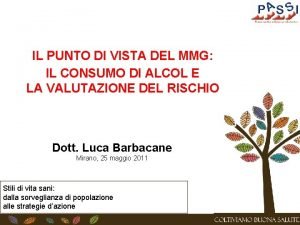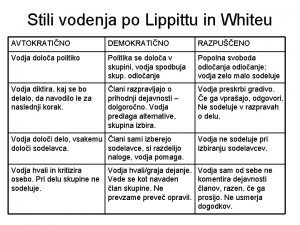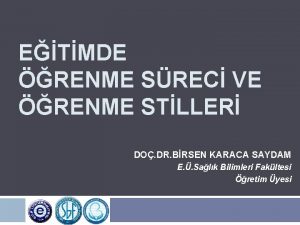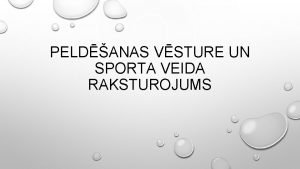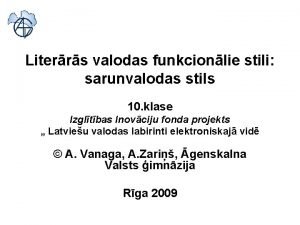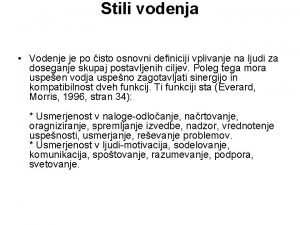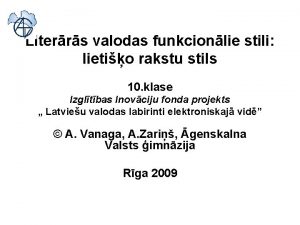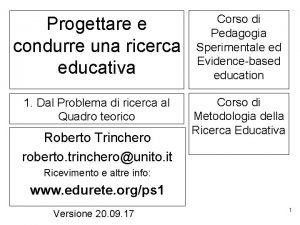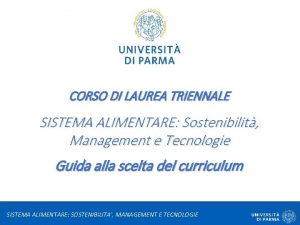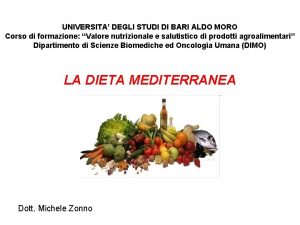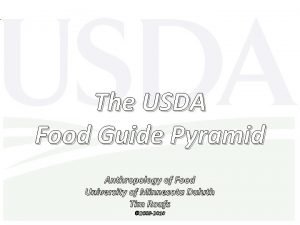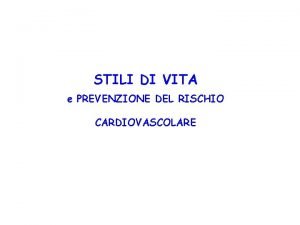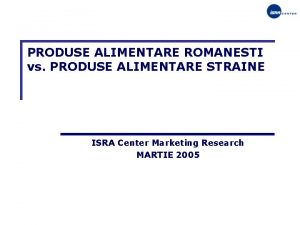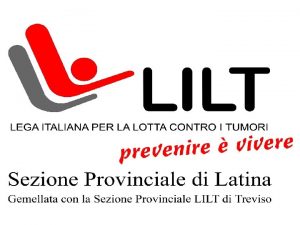EDUCAZIONE ALIMENTARE STILI DI VITA e prevenzione delle





























































- Slides: 61

EDUCAZIONE ALIMENTARE STILI DI VITA e prevenzione delle malattie cronico-degenerative

MALATTIE CARDIOVASCOLARI - CV Ø Ø Ø cardiopatia ischemica ipertensione arteriosa malattie circolatorie dell’encefalo aritmie malattie dei vasi Principali esiti: • infarto miocardico acuto • insufficienza cardiaca • morte improvvisa • ictus

MALATTIE CARDIOVASCOLARI ØDall’ 80 al 90% delle persone che muoiono per malattia ischemica cardiaca presenta 1 o più fattori di rischio maggiori correlati allo stile di vita. ØPiù del 50% dei decessi e disabilità da malattie CV potrebbe essere evitato controllando i fattori di rischio maggiori quali ipertensione, ipercolesterolemia, obesità, sedentarietà e fumo di tabacco. WHO (2003), The World Health Report 2003 - Shaping the future.

FATTORI DI RISCHIO CV Non Modificabili Ø Età Ø Sesso Maschile Ø Familiarità Modificabili Ø Fumo Ø Ipertensione arteriosa Ø Obesità (addominale) Ø Dislipidemie ( Col tot, LDL, TG, HDL) Ø Diabete mellito Ø Errori dietetici Ø Sedentarietà World Health Organization - WHO, The Atlas of Heart Disease and Stroke Geneva, 2004.

PROMOZIONE STILI DI VITA SANI VIAGGIAMO NEL FUTURO ALIMENTARE LA SALUTE Attività motoria BENESSERE E SICUREZZA NEGLI AMBIENTI DI VITA PROMOZIONE DI SANI STILI DI VITA PREVENZIONE PRIMARIA MALATTIE CARDIOCEREBROVASCOLARI MONDO SENZA FUMO PREVENZIONE PRIMARIA MALATTIE ONCOLOGICHE SVILUPPO E BENESSERE DELLA PERSONA Malattie Infettive Salute orale Corretto utilizzo farmaci

FUMO di TABACCO IN ITALIA üI fumatori sono circa 13 milioni üNegli ultimi 30 anni la prevalenza nei maschi si è abbassata, passando dal 55% al 30% üNelle donne al contrario, vi è stato un incremento pari al 21% di prevalenza ü Tra gli adolescenti la diffusione del fumo è andata aumentando ü La maggior parte dei ragazzi inizia a fumare prima dei 18 anni ü Difficilmente chi non ha ancora iniziato a fumare a quest’età inizierà più tardi Modificabili Dagli un taglio

DANNI DA FUMO DI SIGARETTA 20 – 25% 80 – 85% incidenti cardiovascolari bronchiti croniche Prima causa evitabile di morte In Italia 90. 000 morti/anno (17%) 30% 90 – 95% tutti tumori polmonari

FUMO PASSIVO L’esposizione aumenta il rischio di Cancro al polmone + 26% Problemi cardiaci + 25% Basso peso alla nascita per esposizione materna + 20% Morte improvvisa nascituri + 100% Nei bambini di genitori fumatori otiti, bronchiti, sibili, crisi d’asma + 14 / + 72%

FUMO e MALATTIE CV Ø Dopo l’età è il fattore nell’aumento del rischio CV più importante Ø La nicotina accelera il battito cardiaco e aumenta la pressione arteriosa; Ø Il monossido di carbonio diminuisce la quantità di ossigeno nel sangue e favorisce lo sviluppo di aterosclerosi; Ø Smettendo di fumare, dopo un anno il rischio di malattia CV si dimezza, dopo qualche anno il rischio dovuto al fumo scompare.

Modificabili IPERTENSIONE ARTERIOSA üValori desiderabili nelle persone adulte: PA Max < 140 mm. Hg e PA Min < 90 mm. Hg üUna pressione arteriosa elevata costringe il cuore a un super lavoro e accelera la formazione di aterosclerosi üE’ il fattore di rischio più importante in assoluto per ictus ü In Italia 33% degli uomini e 31% delle donne sono ipertesi ü Anziani (52 -57%) e donne in menopausa (49%)

Modificabili ALTERAZIONI LIPIDICHE NEL SANGUE Valori desiderabili: Ø Colesterolo totale < 200 mg/dl Ø Colesterolo LDL < 130 mg/dl Ø Colesterolo HDL > 45 mg/dl per i maschi e > 55 mg/dl per le donne Ø TG < 150 mg/dl Valori borderline Colesterolo totale TG In presenza di 2 o più fattori di rischio 200 – 239 mg/dl 150 – 199 mg/dl Colesterolo LDL < 100 -130 mg/dl

Modificabili ALTERAZIONI LIPIDICHE NEL SANGUE ITALIA Ø 21% degli uomini e 25% delle donne ha Colesterolemia totale superiore a 240 mg/dl. Ø 62% degli uomini e 61% delle donne ha un livello di Colesterolo LDL > 130 mg/dl. Ø 30% degli uomini e 17% delle donne ha un livello di TG > 150 mg/dl

Modificabili DIABETE Ø Glicemia a digiuno 126 mg/dl (almeno 8 h) oppure Ø Glicemia 200 mg/dl (indip. dall’assunzione di cibo) oppure Ø Glicemia 200 mg/dl 2 h dopo carico orale di glucosio Condizioni di alterata tolleranza glucidica Ø Valori desiderabili glicemia a digiuno 100 mg/dl Ø Alterata glicemia a digiuno IFG se valori compresi tra 100 e 125 mg/dl Ø Ridotta Tolleranza al Glucosio IGT glicemia 140 -199 mg/dl 2 h dopo carico orale di glucosio

DIABETE ♀ 4, 6% Di cui solo il 13% in adeguato trattamento Incidenza del 4, 5% (dati ISTAT 2006) ♂ 4, 3% Di cui solo il 14% in adeguato trattamento Altrettanti soggetti sono malati senza saperlo Oltre il 90% affetti da diabete tipo II, la maggioranza sovrappeso/obesi

COMPLICANZE DIABETE Cardiovascolari Ipertensione, cardiopatie, ictus Renali Insufficienza renale Oculari Retinopatia diabetica, cataratta Sistema nervoso Disturbi della sensibilità, dolori agli arti inferiori o alle mani, digestione lenta o alterazioni dell'alvo, sindrome del tunnel carpale, impotenza sessuale.

Modificabili OBESITA’ Indice di Massa Corporea (BMI) 30 kg/m² Circonferenza vita 102 cm Maschi e 88 cm Femmine Fattore di rischio indipendente per CVD Indice di Massa Corporea (BMI) = Peso(kg) Altezza 2 (m 2) BMI Body Mass Index Valori desiderabili di BMI 18, 5 – 25 kg/ m 2

Classi di peso secondo BMI 18. 5 25 30 SOVRAP SOTTO NORMOPESO OBESITA’ Peso desiderabile = BMI desiderabile x Altezza 2 (m 2) BMI desiderabile compreso tra 18. 5 e 25

OBESITA’ Dati Istat

COMPLICANZE OBESITA’ Cardiovascolari Ipertensione arteriosa, cardiopatie Respiratorie Ipoventilazione, ipossia, apnee notturne, poliglobulia Metaboliche Insulino-resistenza, diabete, dislipidemia Osteoarticolari Piede piatto, ginocchio valgo, patologie del rachide, artropatie Calcolosi biliare, steatosi epatica Oncologiche Cancro mammella, utero, reni, esofago, colon-retto, prostata, ovaio, colecisti Endocrine e della riproduzione Ovaio policistico, ridotta fertilità, alterazioni ormonali (cortisolo, estrogeni, . . ) Psicologiche Depressione, Bassa autostima

Modificabili SEDENTARIETA’ Ø Raddoppia il rischio di malattie CV, diabete e obesità Ø Contribuisce a ridurre l’efficienza del muscolo cardiaco e ad aumentare la pressione arteriosa. Ø Contribuisce ad aumentare i livelli di colesterolo LDL, abbassare l’ HDL e aumentare la glicemia Ø In Italia, in media, il 34% degli uomini e il 46% delle donne non svolge alcuna attività fisica durante il tempo libero. Ø La pratica di regolare attività fisica diminuisce progressivamente con l’età in entrambi i sessi.

Modificabili ERRORI DIETETICI Ø Ø Ø Inadeguato consumo di frutta e verdura Carenza di fibra alimentare Elevata assunzione di grassi saturi e di colesterolo Scarsa assunzione di grassi polinsaturi 3 e 6 Eccessiva assunzione di sale Elevato consumo di alcool

Le 10 regole d’oro per prevenire il rischio cardiovascolare 1. Evita il fumo sia attivo che passivo 2. Aumenta il consumo giornaliero di verdura e frutta: segui la regola delle 5 porzioni e dei differenti colori 3. Aumenta il consumo settimanale di pesce, legumi e cereali (pane, pasta o riso) ad alto contenuto di fibre 4. Limita il consumo di grassi, formaggi e dolci 5. Limita il consumo di sale e modera il consumo di alcool 6. Controlla il peso e mantieniti sempre attivo 7. Svolgi un’adeguata attività fisica 8. Tieni sotto controllo la pressione arteriosa 9. Tieni sotto controllo il valore di colesterolo 10. Tieni sotto controllo il valore della glicemia Progetto cuore, Istituto Superiore di Sanità

Indice Linee Guida per una Sana Alimentazione Italiana 1. Controlla il peso e mantieniti sempre attivo 2. Più cereali, legumi, ortaggi e frutta 3. Grassi: scegli la qualità e limita la quantità 4. Zuccheri, dolci bevande zuccherate: nei giusti limiti 5. Bevi ogni giorno acqua in abbondanza 6. Il Sale? Meglio poco 7. Bevande alcoliche: se sì, solo in quantità controllata 8. Varia spesso le tue scelte a tavola 9. Consigli speciali persone speciali 10. La sicurezza dei tuoi cibi dipende anche da te Istituto Nazionale di Ricerca per gli Alimenti e la Nutrizione-INRAN, 2003

COMPOSIZIONE CORPOREA

Gross Composition of Human Body o Body composition analysis often focuses on the tissue and whole body levels of multi-component model.

Different Levels of BC Measurement Fahey/Insel/Roth, Fit & Well: Core Concepts and Labs in Physical Fitness and Wellness, Chapter 6

What Is Body Composition? Body composition = the body’s relative amounts of fat mass and fatfree mass (bone, water, muscle, connective and organ tissues, teeth) n Essential fat = crucial for normal body functioning n 3– 5% of total body weight in males n 8– 12% of total body weight in females n n Nonessential fat = adipose tissue Fahey/Insel/Roth, Fit & Well: Core Concepts and Labs in Physical Fitness and Wellness, Chapter 6

Typical Body Composition Fahey/Insel/Roth, Fit & Well: Core Concepts and Labs in Physical Fitness and Wellness, Chapter 6

Total Body Fluid by Compartment Total Body Water

Electrolyte Composition of Body Fluid Compartments

Variazioni della composizione corporea con la crescita e l’invecchiamento. (Da Puig M: "Body composition and growth, " in Nutrition in Pediatrics, ed. 2, 1996)

Gross Composition of Body n n n Essential fat: fat in organs, muscle, CNS, bone marrow. Also includes sex-specific essential fat necessary for survival. Storage fat: energy reserve includes visceral adipose tissue & larger subcutaneous depots. Fat Free Body Mass and Lean Body Mass n n n In vivo, it isn’t possible to differentiate between essential and non-essential fat. LBM =FFM (bone, muscle, organs, connective tissue) + essential fat. Density of human fat is. 901 g/cm 3. FFM varies. Fahey/Insel/Roth, Fit & Well: Core Concepts and Labs in Physical Fitness and Wellness, Chapter 6

Gross Composition of Body n n n Density of FFM lower in children than adults. Female density of FFM is lower at each age than male. Percentage of FFM that is composed of water is higher in children. Fahey/Insel/Roth, Fit & Well: Core Concepts and Labs in Physical Fitness and Wellness, Chapter 6

Reference Female Body mass = skeleton+skin+subcutaneous tissue+skeletal muscle+remainder (% of total body mass) Fahey/Insel/Roth, Fit & Well: Core Concepts and Labs in Physical Fitness and Wellness, Chapter 6

Reference Female Fahey/Insel/Roth, Fit & Well: Core Concepts and Labs in Physical Fitness and Wellness, Chapter 6

Reference Male Fahey/Insel/Roth, Fit & Well: Core Concepts and Labs in Physical Fitness and Wellness, Chapter 6

Male vs Female (note differences in fat and muscle content ) Fahey/Insel/Roth, Fit & Well: Core Concepts and Labs in Physical Fitness and Wellness, Chapter 6

What is Essential Fat? Consists of fat stored in major organs, muscles, and central nervous system 4 Important for childbearing and hormone-related functions 4 Required for normal physiological functioning: reducing essential fat below some minimal amount can impair overall health. Extremes in dieting (and exercise) can reduce essential fat stores) Fahey/Insel/Roth, Fit & Well: Core Concepts and Labs in Physical Fitness and Wellness, Chapter 6

Sex Differences in Essential Fat Women Men 3% 12% Of this amount, 5 to 9% is called sexspecific, reserve storage fat contained in breast and genital regions, lower body subcutaneous fat, and intramuscular depots Fahey/Insel/Roth, Fit & Well: Core Concepts and Labs in Physical Fitness and Wellness, Chapter 6

Sex Differences in Storage Fat Storage fat accumulates mainly in adipose tissues. This fat depot includes visceral fatty tissues and adipose tissue deposited beneath the skin’s surface called subcutaneous fat Men Women 12% 15% Fahey/Insel/Roth, Fit & Well: Core Concepts and Labs in Physical Fitness and Wellness, Chapter 6

Distribution of Adipose Tissue Fahey/Insel/Roth, Fit & Well: Core Concepts and Labs in Physical Fitness and Wellness, Chapter 6

Health Consequences of “Thinness” ü Ammenorrhea (completion cessation of menses) occurs in 2 to 5% of women of reproductive age, and 40% of female athletic groups such as dancers, skaters, cheerleaders, gymnasts, cross-country runners ü Oligomenorrhea (irregular menstrual cycles) or amenorrhea increases the risk of bone loss and musculoskeletal injury in premenopausal women Leanness is not the only factor to play a role in menstrual irregularities. Many physically active females fall below critical fat levels (about 17% body fat), yet still have normal menstrual cycles. Some amenorrheic athletes have normal body fat percentage Fahey/Insel/Roth, Fit & Well: Core Concepts and Labs in Physical Fitness and Wellness, Chapter 6

Problems Associated with Very Low Levels of Body Fat n Too little body fat is associated with reproductive, circulatory, osteoporosis, fractures, and immune system disorders Less than 10– 12% for women n Less than 5% for men n Fahey/Insel/Roth, Fit & Well: Core Concepts and Labs in Physical Fitness and Wellness, Chapter 6

Female Athlete Triad n A condition consisting of three interrelated disorders Fahey/Insel/Roth, Fit & Well: Core Concepts and Labs in Physical Fitness and Wellness, Chapter 6

Overweight and Obesity n n n The most important consideration in evaluating body weight and composition is the proportion of total body weight that is fat (percent body fat) Overweight = total body weight above a recommended range for good health Obesity = severely overweight and overfat; characterized by excessive accumulation of body fat Fahey/Insel/Roth, Fit & Well: Core Concepts and Labs in Physical Fitness and Wellness, Chapter 6

Prevalence of Overweight and Obesity Fahey/Insel/Roth, Fit & Well: Core Concepts and Labs in Physical Fitness and Wellness, Chapter 6

Excess Body Fat and Wellness n Increased risk of chronic disease and premature death; associated health problems include n n n n n Unhealthy blood fat levels Impaired heart function Heart disease and hypertension Cancer Impaired immune function Gallbladder disease Kidney disease Skin problems Sleeping problems Fahey/Insel/Roth, Fit & Well: Core Concepts and Labs in Physical Fitness and Wellness, Chapter 6

Body Composition and Cancer Mortality Fahey/Insel/Roth, Fit & Well: Core Concepts and Labs in Physical Fitness and Wellness, Chapter 6

Body Composition and Diabetes Obese people are more than three times as likely as nonobese people to develop diabetes n Excess body fat is a key risk factor for the most common type of diabetes n Fahey/Insel/Roth, Fit & Well: Core Concepts and Labs in Physical Fitness and Wellness, Chapter 6

Body Mass Index and Risk of Type 2 Diabetes Fahey/Insel/Roth, Fit & Well: Core Concepts and Labs in Physical Fitness and Wellness, Chapter 6

Diabetes n Diabetes mellitus = disruption of normal glucose metabolism Type 1 diabetes = the pancreas produces little or no insulin n Type 2 diabetes = the pancreas doesn’t produce enough insulin, cells are resistant to insulin, or both n Gestational diabetes = develops in 2– 5% of pregnant women n Pre-diabetes = elevated blood glucose levels n Fahey/Insel/Roth, Fit & Well: Core Concepts and Labs in Physical Fitness and Wellness, Chapter 6

Diabetes Fahey/Insel/Roth, Fit & Well: Core Concepts and Labs in Physical Fitness and Wellness, Chapter 6

Diabetes: Symptoms Fahey/Insel/Roth, Fit & Well: Core Concepts and Labs in Physical Fitness and Wellness, Chapter 6

Diabetes: Prevention Regular physical activity including endurance exercise and weight training n Moderate diet rich in whole grains, fruits, vegetables, legumes, fish, and poultry n Modest weight loss n For people with pre-diabetes, lifestyle changes are more effective than medication in preventing diabetes n Fahey/Insel/Roth, Fit & Well: Core Concepts and Labs in Physical Fitness and Wellness, Chapter 6

Body Fat Distribution and Chronic Disease n Location of fat is important to health People who gain weight in the abdominal area = “apples; ” this group has an increased risk of coronary heart disease, high blood pressure, diabetes, and stroke n People who gain weight in the hip area= “pears” n Fahey/Insel/Roth, Fit & Well: Core Concepts and Labs in Physical Fitness and Wellness, Chapter 6

Physical Activity, Overweight, and Risk of Death Fahey/Insel/Roth, Fit & Well: Core Concepts and Labs in Physical Fitness and Wellness, Chapter 6

Body Composition Changes for Adults in the U. S 15. 8 Because of the typical reduction in physical activity, each year the average person gains 1. 5 lbs of body fat and loses a half a pound of lean tissue Fahey/Insel/Roth, Fit & Well: Core Concepts and Labs in Physical Fitness and Wellness, Chapter 6

Making Changes in Body Composition n Lifestyle should focus on: n Regular physical activity, endurance exercise, and strength training Fahey/Insel/Roth, Fit & Well: Core Concepts and Labs in Physical Fitness and Wellness, Chapter 6

Making Changes in Body Composition n Lifestyle should focus on: Moderate energy intake n Physical activity is the key to long-term success n Fahey/Insel/Roth, Fit & Well: Core Concepts and Labs in Physical Fitness and Wellness, Chapter 6

Effects of a 6 -Week Aerobics Exercise Program on Body Composition n 4. 9 Loss of lean body mass can be offset or eliminated by combining a sensible diet with physical exercise Fahey/Insel/Roth, Fit & Well: Core Concepts and Labs in Physical Fitness and Wellness, Chapter 6

VALUTAZIONE DELLA COMPOSIZIONE CORPOREA
 Simile
Simile Laboratorio di educazione alimentare
Laboratorio di educazione alimentare Progetto sull alimentazione scuola primaria
Progetto sull alimentazione scuola primaria Stili di vita sani
Stili di vita sani Stili di vita alternativi
Stili di vita alternativi Colomba simbolo pace
Colomba simbolo pace Ufficio prevenzione infortuni
Ufficio prevenzione infortuni Dipartimento prevenzione asl viterbo
Dipartimento prevenzione asl viterbo Forum prevenzione incendi
Forum prevenzione incendi Regola tecnica prevenzione incendi
Regola tecnica prevenzione incendi Vita highschool vita
Vita highschool vita L'esperienza delle cose moderne e la lezione delle antique
L'esperienza delle cose moderne e la lezione delle antique Cose moderne
Cose moderne La nascita delle lingue e delle letterature romanze
La nascita delle lingue e delle letterature romanze Mācīšanās stili
Mācīšanās stili Stili vodenja
Stili vodenja Stili cognitivi
Stili cognitivi Kariyer stili değerlendirmesi
Kariyer stili değerlendirmesi Kolb öğrenme stili
Kolb öğrenme stili Leksiskie
Leksiskie Stile analitico
Stile analitico Peldēšanas stili
Peldēšanas stili Shkrimi apa
Shkrimi apa Kariyer soy ağacı
Kariyer soy ağacı Kolb öğrenme stilleri
Kolb öğrenme stilleri Stili dhe kompozicioni
Stili dhe kompozicioni Valodas funkcijas 10 klase
Valodas funkcijas 10 klase Kaynakça örnekleri
Kaynakça örnekleri Stili vodenja
Stili vodenja Stili comunicativi
Stili comunicativi Valodas stili 5 klase
Valodas stili 5 klase Stile cognitivo e stile di apprendimento
Stile cognitivo e stile di apprendimento Educazione civica schemi
Educazione civica schemi Terzo settore
Terzo settore Condurre una ricerca
Condurre una ricerca Pestalozzi biografia
Pestalozzi biografia Metodologia della ricerca in educazione e formazione
Metodologia della ricerca in educazione e formazione Compito di realtà educazione stradale
Compito di realtà educazione stradale Competenze educazione fisica scuola secondaria primo grado
Competenze educazione fisica scuola secondaria primo grado I diritti umani tesina
I diritti umani tesina Esempi di norme religiose
Esempi di norme religiose Progetto arezzo cuore
Progetto arezzo cuore Primi tentativi di educazione dei ciechi
Primi tentativi di educazione dei ciechi Educazione alla diversità
Educazione alla diversità Educazione attiva
Educazione attiva Dario mazzoli unimore
Dario mazzoli unimore Woolfolk psicologia dell'educazione
Woolfolk psicologia dell'educazione Marietti scuola educazione fisica
Marietti scuola educazione fisica L'educazione ad atene
L'educazione ad atene Dipartimento dell'educazione della cultura e dello sport
Dipartimento dell'educazione della cultura e dello sport Edgar morin i sette saperi
Edgar morin i sette saperi La ricerca qualitativa in educazione
La ricerca qualitativa in educazione Tricotomico
Tricotomico Catena alimentare stagno
Catena alimentare stagno Sistema alimentare sostenibilità management e tecnologie
Sistema alimentare sostenibilità management e tecnologie Piramide alimentare spagnola
Piramide alimentare spagnola Avvocato diritto alimentare
Avvocato diritto alimentare Banco alimentare imola
Banco alimentare imola Piramide asiatica
Piramide asiatica Un ecosistema di cura eh
Un ecosistema di cura eh Il sistema haccp governa e concerne
Il sistema haccp governa e concerne Old food pyramid vs new
Old food pyramid vs new



